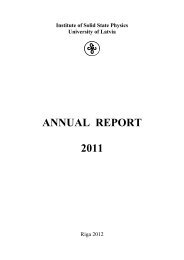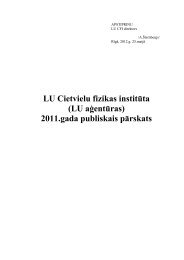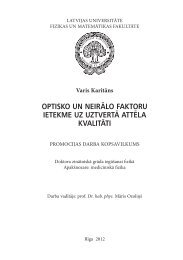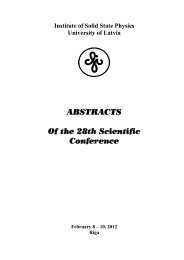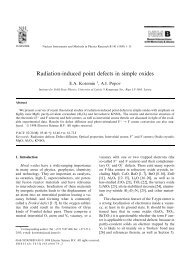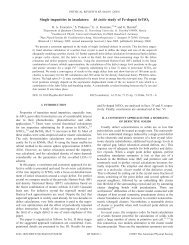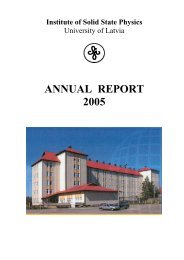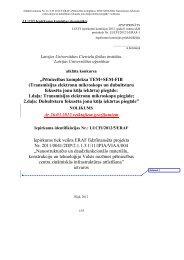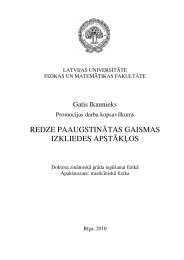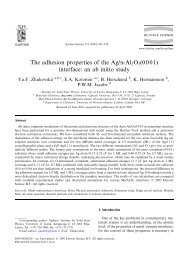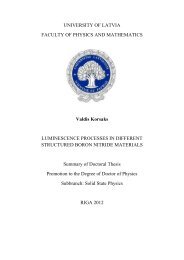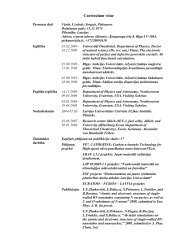Annual Report 2012 - Latvijas Universitātes Cietvielu fizikas institūts
Annual Report 2012 - Latvijas Universitātes Cietvielu fizikas institūts
Annual Report 2012 - Latvijas Universitātes Cietvielu fizikas institūts
You also want an ePaper? Increase the reach of your titles
YUMPU automatically turns print PDFs into web optimized ePapers that Google loves.
Israel<br />
Technion, Haifa (Dr.S.Stolyarova).<br />
Russia<br />
Institute of Solid State Physics RAN, Chernogolovka (Prof.B.Straumal, Dr.V.Sursajeva)<br />
Main Results<br />
SHEAR BANDING MECHANISM OF PLASTIC DEFORMATION IN LiF<br />
IRRADIATED WITH SWIFT HEAVY IONS<br />
J Maniks, R Zabels, I Manika<br />
The effect of ion irradiation on the behavior of plastic deformation at micro- and<br />
nanoindentation on (001) face of LiF has been investigated. The irradiation was<br />
performed using heavy ions (U, Au, Ti and S) with energy in the range from 3 MeV to 2<br />
GeV at fluences up to 5x10 13 ions/cm 2 . In non-irradiated LiF, the indentation produces<br />
dislocation gliding on the {110} planes along the and directions. At high<br />
fluence irradiation, the resource of the dislocation slip along the preferable directions<br />
becomes exhausted due to immobilization of dislocations by radiation defects and their<br />
aggregates. The present study demonstrates the change of the mechanism of plastic<br />
deformation from homogenous dislocation slip to localized shear banding in samples<br />
irradiated to high fluences. The factors facilitating of the localization of deformation<br />
have been analyzed<br />
DEFORMATION BEHAVIOR OF NANOSTRUCTURED ZnO<br />
FILMS ON GLASS<br />
R. Zabels, F. Muktepavela, L. Grigorjeva<br />
Nanostructured ZnO films on glass substrate were studied by nanoindentation, scanning<br />
electron and atomic force microscopy. The films were obtained by a straightforward<br />
mechanoactivated oxidation method. The morphology of the obtained films was grained<br />
with a grain size in the range 50–100 nm and the thickness was approximately 2 μm. A<br />
detailed deformation behavior of ZnO films, critical parameters and indentation induced<br />
plastic deformation mechanisms were determined in correlation to bulk ZnO, Si single<br />
crystal and commercial ZnO films. In comparison to a single crystal ZnO,<br />
nanostructured films exhibit increased hardness (9 GPa); however, the Young's modulus<br />
is decreased (120 GPa). A directly detectable evidence of brittleness, “pop-in” and “pileup”<br />
phenomena in ZnO films was not observed. The ZnO/glass interface is stable and<br />
exhibits high adhesion, no signs of delamination or presence of brittleness cracks were<br />
detected (even at load Pmax>2 N). The role of grain boundaries on the properties of<br />
deformation behavior of ZnO nanostructured films has been discussed.<br />
Scientific publications<br />
SCI publications<br />
1. R. Zabels, F. Muktepavela, L. Grigorjeva. Deformation behavior of<br />
nanostructured ZnO films on glass. Thin Solid Films 520 (<strong>2012</strong>) 4685–4688.<br />
2. I. Manika, J. Maniks, R. Zabels, J. Gabrusenoks, M. Krause, M. Tomut, K.<br />
Schwartz. Nanoindentation and Raman Spectroscopic Study of Graphite<br />
107



